NEAR HARRISBURG–In bone-dry Banner County, clouds of dirt drift into the sky as rumbling tractors till the sun-baked soil.
In some fields, the ground is still too dry to start planting winter wheat.
“This is the first time in my life I haven’t been able to get wheat in the ground,” said Jim Young, standing in a field that’s been in his family for 80 years. “We get very little rain. And we get a lot of wind.”
Some of the country’s best wind, in fact.
That’s why 16 years ago, wind energy companies started courting landowners up and down County Road 14 north of Kimball — a deep purple smear through the Nebraska Panhandle on wind speed maps. The sign of high-speed, reliable wind.
With about 150,000 acres leased by energy companies, this county of just 625 people stood poised to become home to as many as 300 wind turbines.
It would have been the largest wind project in the state, bringing in loads of money for the landowners, the developers, the county and local schools.
But then, an unexpected roadblock: The U.S. Air Force.
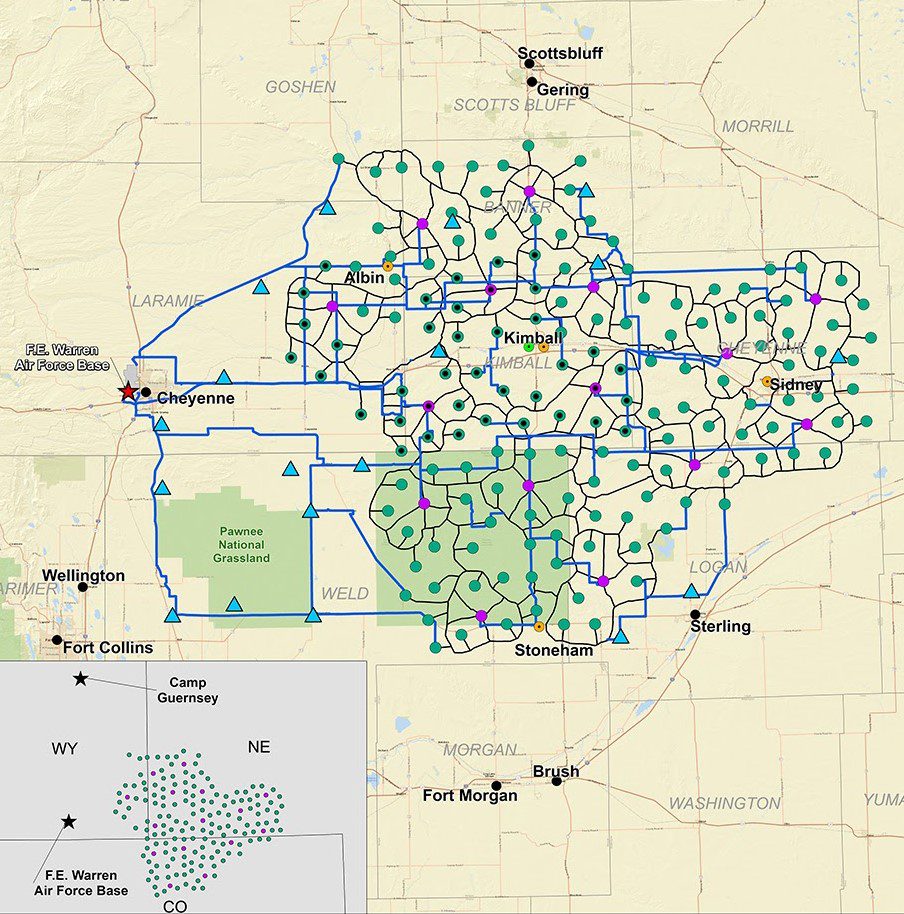
Under the dusty fields of Banner County are dozens of nuclear missiles. Housed in military silos dug more than 100 feet into the ground, the Cold War relics lie in wait across rural America, part of the country’s nuclear defenses.
For decades, tall structures like wind turbines needed to be at least a quarter mile away from the missile silos.
But earlier this year, the military changed its policy.
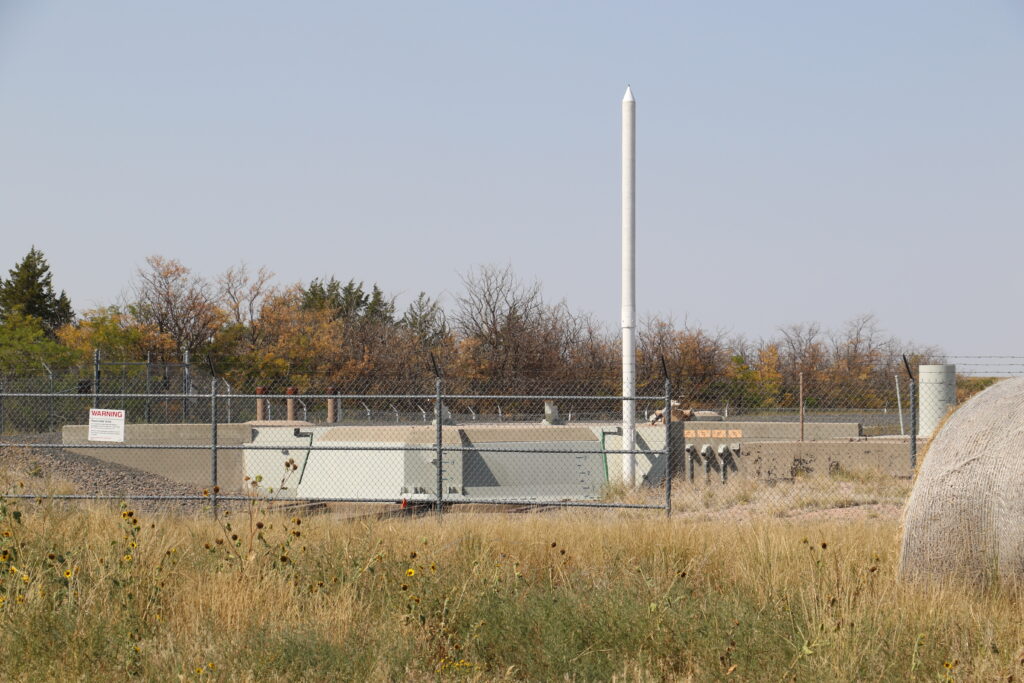
Now, they said, turbines now can’t be within two nautical miles of the silos. The switch ruled out acres of land energy companies had leased from locals — and wrested a potential windfall from dozens of farmers who’d waited 16 years for the turbines to become reality.
The stalled Banner County project is unique, but it’s one more way that Nebraska struggles to harness its main renewable energy resource.
Oft-windy Nebraska ranks eighth in the country in potential wind energy, according to the federal government. The state’s wind energy output has improved markedly in recent years. But Nebraska continues to lag far behind neighbors Colorado, Kansas and Iowa, all of whom have become national leaders in wind.
The Banner County projects would have grown Nebraska’s wind capacity by 25%. It’s now unclear how many turbines will be possible because of the Air Force’s rule change.
“This would have been a big deal for a lot of farmers. And it would have been an even bigger deal for every property owner in Banner County,” Young said. “It’s just a killer. Don’t know how else to say it.”
LIVING WITH NUKES
John Jones was driving his tractor when out of nowhere, helicopters whizzed past overhead. His tractor had kicked up enough dust to trigger a nearby missile silo’s motion detectors.
Jeeps sped up and armed men jumped out to inspect the potential threat.
“I just kept farming,” Jones said.
The people of Banner County have coexisted with the missile silos since the 1960s. To keep up with Soviet nuclear technology, the U.S. began planting hundreds of missiles in the most rural parts of the country, positioning them to shoot up over the North Pole and into the Soviet Union at a moment’s notice.
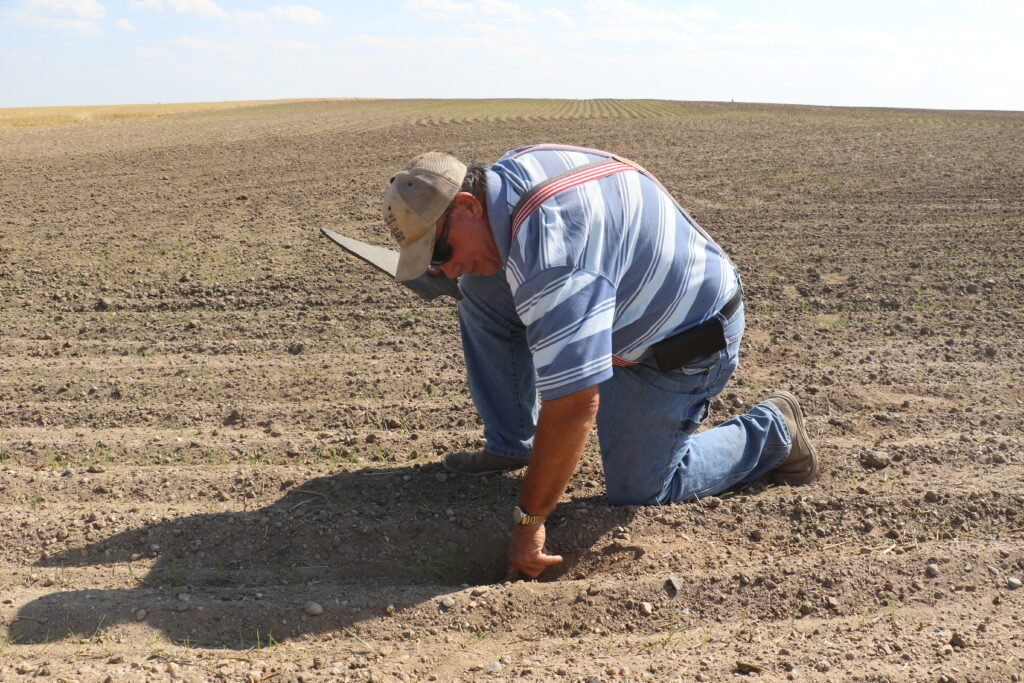
Today, there are decommissioned silos scattered throughout Nebraska. But 82 silos in the Panhandle are still active and controlled 24/7 by Air Force crews.
Four hundred intercontinental ballistic missiles — ICBMs — are burrowed in the ground across northern Colorado, western Nebraska, Wyoming, North Dakota and Montana. The 80,000-pound missiles can fly 6,000 miles in less than a half-hour and inflict damage 20 times greater than the bombs dropped on Hiroshima in World War II.
“If we ever get bombed, they say this is the first place they’re going to bomb, because of the silos that we’ve got here,” said farmer Tom May.
Every acre of May’s property sits within the two miles of a missile silo. Under the new Air Force rule, he can’t put a single wind turbine on his ground.
Wind turbine developers first came to Banner County about 16 years ago – men in polos and dress pants who held a public meeting for interested landowners at the school in Harrisburg.
Banner had what developers called “world-class wind.” Many landowners were eager – signing away their acres came with the promise of roughly $15,000 per turbine per year. The turbines were also going to pump money into the county and school system, said county officials and company executives.
“In Banner County, it would have reduced property taxes to damn near nothing,” Young said they were told.
Eventually, two companies – Invenergy and Orion Renewable Energy Group – finalized plans to put up wind turbines in Banner County.
Environmental impact studies were completed. Permits, leases and contracts were signed.
Orion had 75 to 100 turbines planned, and hoped to have a project operating by this year.
Invenergy was going to build as many as 200 turbines. The company had qualified for federal tax credits to start the project and had even poured the concrete pads that the turbines would sit upon, covering them back up with earth so farmers could use the land until construction began.
But discussions with the military starting in 2019 brought the projects to a screeching halt.
Wind turbines pose a “significant flight safety hazard,” an Air Force spokesman said in an email. Those turbines didn’t exist when the silos were built. Now that they dot the rural landscape, the Air Force said it needed to reevaluate its setback rules. The final number it settled on was two nautical miles — 2.3 miles on land — so helicopters wouldn’t crash during blizzards or storms.
The distance was necessary to keep aircrews safe during “routine daily security operations, or critical contingency response operations, while also co-existing with our fellow Americans who own and work the land around these vital facilities,” a spokesman said.
In May, military officials traveled from Wyoming’s F.E. Warren Air Force Base to break the news to landowners. On an overhead projector at Kimball’s Sagebrush Restaurant, they showed enlarged photos of what helicopter pilots see when flying near turbines in a snowstorm.
For most landowners, the news came as a gutpunch. They said they support national security and keeping service members safe. But they wonder: Is eight times as much distance necessary?
“They don’t own that land. But all of a sudden, they have the power to strike the whole thing down, telling us what we can and can’t do,” Jones said. “All we’d like to do is negotiate. 4.6 miles [diameter] is way too far, as far as I’m concerned.”
Off County Road 19, a chain link fence separates a missile silo entrance from surrounding farmland. Young parks across the road and points over a hill to a meteorological tower put in by an energy company.
There are acres of farmland between the missile silo and the tower. The tower Young is pointing to appears as a small line on the horizon, topped with a blinking red light.
“When you can land a helicopter on top of any hospital in the country, they’re saying that this is too close,” Young said, pointing to the missile silo and the distant tower. “Now you know why we’re pissed, right?”
WIND ENERGY IMPROVING, BUT STILL LAGGING
Nebraska built its first wind turbines in 1998 — two towers west of Springview. Installed by the Nebraska Public Power District, the pair were a test run for a state whose neighbor Iowa had been promoting wind energy since the early 1980s.
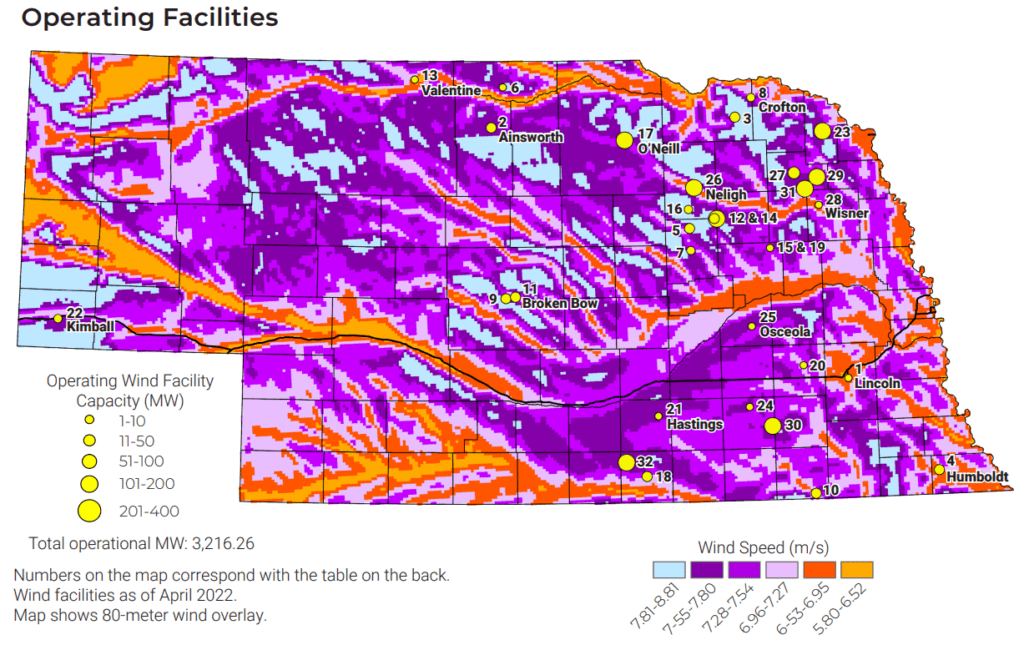
By 2010, Nebraska was 25th in the country at producing wind-generated power — the bottom of the pack among windy Great Plains states.
The reasons fueling the lag were uniquely Nebraskan. Nebraska is the only state served entirely by publicly owned utilities, mandated to deliver the cheapest electricity possible.
Federal tax credits for wind farms only applied to the private sector. With a smaller population, already cheap electricity and limited access to transmission lines, Nebraska lacked the market to make wind energy worthwhile.
A decade of legislation helped change that calculus. Public utilities were allowed to buy power from private wind developers. A state law diverted taxes collected from wind developers back to the county and school district — the reason the Banner wind farms may have shrunk taxes for county residents.
Now, Nebraska has enough wind turbines to generate 3,216 megawatts, moving to fifteenth in the nation.
It’s modest growth, experts said. But with new federal legislation incentivizing wind and solar energy, and the three largest Nebraska public power districts committing to going carbon neutral, wind energy in the state is expected to accelerate.
The biggest obstacle now may be Nebraskans who don’t want wind turbines in their counties.
The turbines are noisy eyesores, some say. Without federal tax credits, they aren’t necessarily a financially wise way to generate electricity, said Tony Baker, legislative aide for Sen. Tom Brewer.
In April, Otoe County Commissioners imposed a one-year moratorium on wind projects. In Gage County, officials passed restrictions that would prevent any future wind development. Since 2015, county commissioners in Nebraska have rejected or restricted wind farms 22 times, according to energy journalist Robert Bryce’s national database.
“The first thing we heard out of everyone’s mouth was how, ‘We don’t want those damn wind turbines next to our place,’” Baker said, describing visits with Brewer’s Sandhills constituents. “Wind energy tears apart the fabric of communities. You have a family that benefits from it, wants it, but everybody that neighbors them doesn’t.”

John Hansen, president of the Nebraska Farmers Union, said pushback over wind farms has ramped up in recent years. But it’s a loud minority, he said. Eighty percent of rural Nebraskans thought more should be done to develop wind and solar energy, according to a 2015 University of Nebraska-Lincoln poll.
“It’s that NIMBY problem,” Hansen said, using the acronym meaning, “Not in My Backyard.” It’s, “‘I’m not against wind energy, I just don’t want it in my area.’ Their goal is to make sure that no project gets built, period.”
For Nebraska towns facing shrinking populations, wind turbines can mean economic opportunity, Hansen said. In Petersburg, the influx of workers after a wind farm was built led a failing grocery store to instead build a second location, he said. It’s the equivalent of a part-time job for farmers who agree to turbines.
“It’s like having an oil well on your land without all the pollution,” said Dave Aiken, a UNL ag economics professor. “You’d think it would be a no-brainer.”
In Banner County, the economic benefit would have bled into the surrounding area as well, landowners said. Crews building turbines would have bought groceries and stayed in hotels in neighboring Kimball and Scotts Bluff counties.
Now, the landowners aren’t entirely sure what’s next. Orion said the Air Force decision rules out at least half its planned turbines. It still hopes to have a project running in 2024. Invenergy declined to detail any future plans.
“This resource is just there, ready to be used,” Brady Jones, John Jones’ son, said. “How do we walk away from that? At a time when we’re passing legislation that would vastly increase investment in wind energy in this country? That energy’s got to come from somewhere.”

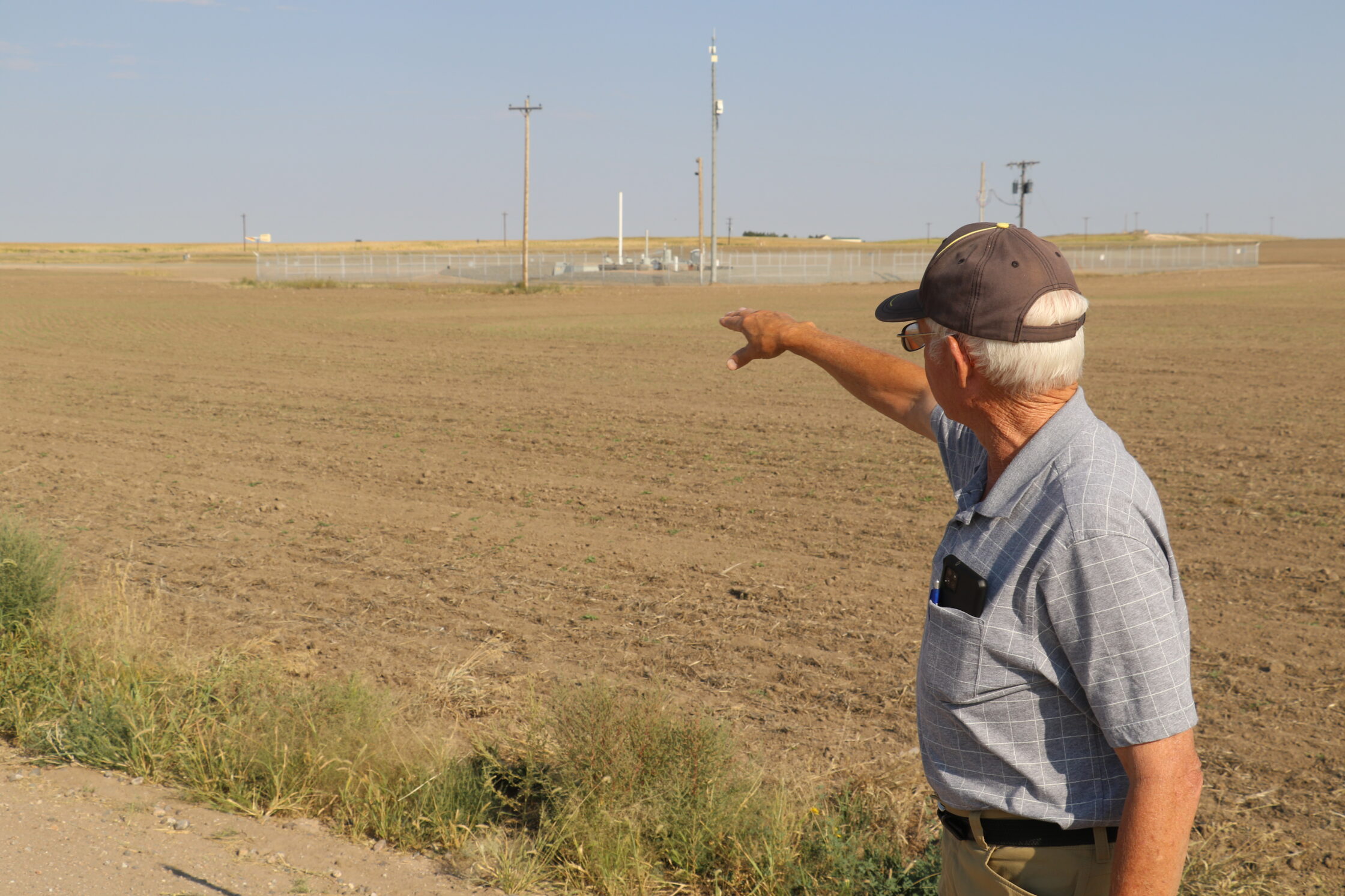


43 Comments
Thank goodness for some common sense. some real investigation into these monster soros. inventions that are killing AMERICA—–ONLY KLEEB, HAS THE STUPIDITY OF DISCARDING OIL and bringing in concrete by the tons—-that lasts in our ground forever, kills all birds, causes anxiety and migraine headaches that make WORKING—GET THAT–WORKING AMERICANS SICK. Good for the Air Force—to think of the future—–
A fine piece of writing showing the conflicts in the wind business.
Ah, a petroleum industry spokesman/shill I presume, or perhaps a Putin Russian plant. In any case, I expect that the Air Force will think again about this and come to a reasonable compromise, lessening the two nautical mile radius.
In time the wind turbines will become unnecessary as new energy technologies come on line. Let our farmers enjoy the benefits that accrue from leasing land to the turbine companies. God knows, the ‘windfalls will be welcome relief providing a clean and needed energy source.
We need the energy and that too is in keeping with our national security interests.
Windmills are giving people migraines?
Be careful…you’re gonna pull a hamstring stretching that far!
This story is very biased and slanted
I say NO to windmills, YES to nuclear, natural gas, hydro, oil, coal. Solar has more to progress in order to make it really a good national choice and fusion will probably make it a dinosaur long before it becomes cost effective and miniaturized. Do not be panicked by the greenies. And if I was given 15G a year, I would want them on my land so I could be rich and live somewhere else where there was NO windmills.
Yah, what do we really KNOW about the sun?!
Good reply Joe. I feel the same.
The bots are strong on this comment section.
You know what a wind farm sounds like? Wind. I’ve been to several here in Texas and the turbines are essentially silent. They can be a danger to birds at the same rate as tall buildings, radio towers, etc. Different ways are being tested to keep birds away. Google toxic coal ash lakes if you want to learn about a much faster way to kill birds. Burning dirty coal, oil and gas is what is making working Americans sick.
We’re not there yet but I can’t wait until coal and oil join lead cups and arsenic makeup in the trash can of history.
Love this. Thank you military. The sound of the windmills I have tented near is horrible and gave me migraines.
they are not bots… progammed bots are MUCH smarter
I agree with you! Thank you!
Good luck that will never happen we will always have oil it’s a dream world if you think we could live without oil because that’s what tires are made of windmills are not worth the cost
I live near 400 wind turbines to the west and north of us. Our weather (rain) usually comes from the west. For the last 3 or 4 years when the rain is coming it splits and goes north or south. If it comes from the south we will get rain. For the green team we have seen nothing but brown. The wind turbines have changed our weather. Count yourself lucky.
Decommissioning of Wind Turbines us the real concern and this is the true problem. The average cost will be 1 million per tower at the end of life 20 yrs. But most towers today don’t make it much over 10 yrs. The blades are a huge problem, they are being buried in Wyoming, dropped in holes in Colorado, recycling has failed for the most part, the concrete base is only removed at 4ft. Alfalfa roots go 20 to 25 ft deep. The tube can at be recycled at least. This will end up costing the land owner lots of money and if they file bankruptcy as the wind tower company will the state will have to bear this cost, we are all tax payers so ultimately we will all pay for something that will be obsolete soon due to technological advances.
Wait until Jan K. Hansen stumbles upon a website other than Facebook and Fox News to learn about the effects of oil and gas on the environment and human health. The conspiratorial, hyperpartisan wackjob will be stunned at what she finds.
Anywho, fascinating read and topic. The opportunities for sustainable energy on our planet are plentiful and will inevitably get corrupted by greed and morons in power who don’t know what the hell they’re talking about (just like everything else these days).
Our military is the largest CO2 emmiter on the planet and here in the heart land of Nebraska US nuclear war heads
preempt one of the many ways we can resolve this world wide problem: clean, renewable. green energy.
PS Love you NE farmers. Less cattle more soy and wheat and corn please.
Cheers
Hi my beloved Crete and Doane University alumni 1970
We have less pollution than most countries wind energy is just a waste of taxpayers money and what problem does cattle create we are not vegan nut jobs beef is the best thing for a person
If the Air Force has veto power over the locations of wind turbines on private property, the Air Force should be required to compensate the owners for the same amount of money that owners would have received for each wind turbine site that was planned but not built, for as long as missiles remain in the affected silos.
I heartily concur!
Vertical axis wind turbine could potentially be a solution to 4 miles restriction. These wind turbines are perpendicular to the ground and do not take that much rotary space.
The comments above ignored the problems the farmers in western US that is mega drought due climate. Any structure natural or man made high enough to birds. When a coal plant or refinery is put i do not hear any opposition.
At least coal and oil are a good investment and they are a great definition of clean energy we will never survive without oil
Support the farmers they are the ones that need it right now. I say wait and see what might be coming that we don’t know about. Things are moving pretty fast these days. Born and raised in Nebraska!
The other concern would be the central fly way. Many birds fly through Nebraska and rest along the Platte River in Central Nebraska.
I didn’t know Nebraska still had so many active missile silos in the state. In the late 1950s numerous Atlas E and F crypts and silos were installed in southeastern Nebraska. They were all deactivated by the mid-1960s.
There is absolutely no need whatsoever for that many nuclear missile silos, period. The Cold War is over. Humanity has learned the true cost of nuclear warfare. Even Russia and Putin don’t have the idiocracy to launch nuclear strikes otherwise Ukraine would be a radioactive powder-keg right now. Yet we are using taxpayer dollars to maintain and man these relics of a time long gone.
Remember…those who live in the past are doomed to repeat it. Reading all these comments of people who rail against wind energy have no clue what they’re talking about. Guess what folks…birds die every day. Animals die every day. Drive down any highway for a few miles and you’ll likely see a plethora of roadkill laying on the sides of the roads and in the ditches. Where are these so called citizens concerned about wildlife safety now? I say raise property taxes on those who dont support wind energy…they’ll change their tune rather quickly.
Humans have done very well at pissing away the one planet which supports us…and for what? To appease a minority of people who speak up in decibels that are exponentially larger than their IQ. It’s merely a matter of time before Mother Earth takes back what is hers so that 5-10k years down the road, the next evolution of the human species studies the fossilized remains of their distant ancestors. (For those lacking the IQ to understand what I’m saying…thats us…we’ll be the fossilized ancestors. We’ll all be dead because some dumbas* republican held an entire world hostage to satisfy their misheld preconceptions of how the world should work.
People who say wind farms are noisy have never been to one. Go see for yourselves. I have. They are silent. And much quieter than an oil rig.
Oil makes us great money and wind energy is just a waste of money honestly they are not reliable and they can never be recycled the parts when decommissioned become hazardous waste
80,000 pound nuclear warhead? Really??.
Sounds like uninformed hiberboly.
Yes we need warheads what’s the problem with having them
No, the entire Minuteman III missile weighs 80,000 pounds. The warhead is a small fraction of that. Most of it is rocket propellant.
John Hansen, this poll does not even hold water…it’s a loud minority, he said. Eighty percent of rural Nebraskans thought more should be done to develop wind and solar energy, according to a 2015 University of Nebraska-Lincoln poll.
Try taking a poll of the good rural people that would have to live around these eye sores and destroy the value of their homes that they worked so hard for. Let’s put them in your back yard, front yard, side yards!!
uhhhh….kinda forgot about going where thi wind is, dincha bucky?
Some apparent very glaring inaccuracies in this story:
– “82 ‘manned’ missile silos” // Reality: 82 unmanned missile silos (launch facilities) controlled by 9 “manned” missile alert facilities
– “80,000 pound warhead” (that would be one very LARGE warhead) // Reality: The whole ICBM weighs approximately 78,000 pounds. The warhead (reentry vehicle) weighs from 400-800 pounds (from open sources).
– Captioned picture “Farmer Jim Young gestures to a missile silo on his land near Harrisburg…” // Reality: All missile facilities are on land purchased and owned by the U.S. Air Force. Caption might be better stated “gestures from (or near) his land.”
How long do they last and what is done with these monsters when decommissioned? Is the mass of concrete used to plant them on removed as well or does the land owner foot that bill? Idea: use the retired parts as a fence between us and Mexico,how about that for recycling;)?!
Thank you Airforce. I live pretty darn close to this area we Don’t want wind turbines Farmers PLS.. Don’t be sellouts..
I no its hot & dry but its going to kill so many of our beautiful birds that migrate every yr.
Know. You KNOW it’s hot and dry.
I know times they are a- changing.
Time to opt for solving human beings involvement in the climate change and leaving behind war.
Are the farmers compensated for having the silos on their property? The article avoids making it clear if the Air Force is already paying for the land use. Maybe there is a way to issue a restriction easement for compensation to the farmers. There is some missing information here.
How did the Air Force originally obtain the land the silos occupy?
Obvious unanswered questions are:
1. What gives the Air Force legal authority to make this decision on the use of land they do not own?
2. Are the affected farmers or energy companies preparing to contest it?
The fact that we are stopping wind power development so that we can have easier access to our nuclear weapons is a sad microcosm of our national priorities.
The nuclear weapons are becoming illegal under International Law under the Treaty for the Prohibition of Nuclear Weapons.
The wind turbines are one answer to the energy needs of the world.
The US Government has been overtaken by the Military Industrial Complex. The People must act to take control back!
Or be the nuclear sponge for the USA’s failed foreign policy.
So sad that we’ve become such babies. Hundreds of thousands died so you would be able to enjoy the freedoms that you have and here you are crying and crying and you make me sick.
Like to me